Key Objectives
In April 2011, GP Practices were encouraged to set up a Patient Representative Group through the Patient Participation Enhanced Service. The purpose this Enhanced Service is to ensure that patients are involved in decisions about the range and quality of services provided and, over time, commissioned by their practice. It aims to encourage and reward GP Practices for routinely asking for and acting on the views of their patients. This includes patients being involved in decisions that lead to changes to the services their practice provides or commissions, either directly or in its capacity as gatekeeper to other services. The Enhanced Service aims to promote the proactive engagement of patients through the use of effective Patient Reference Groups (PRGs) and to seek views from practice patients through the use of a local practice survey. The outcomes of the engagement and the views of patients are to be published on the practice website.
Establishing A PRG At Caritas GP Partnership
The management of Caritas GP Partnership is carried out jointly by the Partners and the Business Manager, Tanya Humphreys. However, patients are registered with one Practice and each Practice operates a different appointment system, e.g. Dial House Medical Centre offers an open surgery every morning, whereas Ellesmere Medical Centre has a triage system in place to deal with any urgent queries. Furthermore, the Practices are placed in different areas of Stockport so their Practice population is also considerably different.
After much consideration, in April 2011, it was decided that separating the responses from patients at each Practice would allow us to identify differences in patient satisfaction between the two Practices and would enable us to focus on issues that were specific to each Practice. Therefore, we effectively set up and ran a PRG for each Practice. This proved to be very successful in 2011/2012 so we carried it through to 2012/2013. Interestingly, the members of both PRGs chose to focus on the same 5 areas for the local patient survey; therefore, we used the same questionnaire across both Practices. The format used to analyse and report on the findings of each PRG is the same; the main differences are in the actions plans (see below).
This is the 2012/2013 Patient Representative Group Report for Caritas GP Partnership, which summarises the development and outcomes of the PRGs at Dial House Medical Centre and Ellesmere Medical Centre.
The following section focuses on Dial House Medical Centre. All the information regarding Ellesmere Medical Centre can be found further down in this report.
Dial House Medical Centre
1. Ongoing promotion of our PRG
To build on last year’s creation of our PRG, we have continued to recruit members. This has been achieved by attaching membership forms to new patient registration forms and placing these forms on our front reception desk for existing patients. As a result of this ongoing promotion, we have recruited 53 new members, bringing our total to 140. From this figure we have 20 who expressed a preference for a face to face meeting, 90 that preferred a virtual group and 30 who stated no preference, but gave us their email addresses.
As new members joined the PRG, we added their details to our PRG database. We monitored how representative our group was on a monthly basis and accordingly with our findings, we targeted the groups that had low or no representation via reception, opportunistically asking these groups if they would be interested in joining the PRG.
2. Profile
The graphs below show the age, sex and ethnicity profile of our PRG compared to our Practice population.
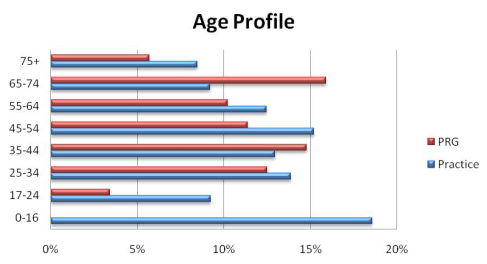
The above chart shows that the PRG distribution is fairly consistent with our Practice population. Nonetheless, the percentage of PRG members in the 17-24 age range is slightly below our expectations; however we are pleased to note that this has increased since last year. We realise that this age group are less likely to come into the Practice regularly and are, therefore, harder to engage. We will continue to focus on this category with a view to increase their representation.
The male/female ratio of our Practice population is even. However, the male representation in our PRG is significantly below the female representation. We identified this as an issue shortly after we started recruiting members and even though we proactively targeted male patients, the female representation is still predominant. We will continue to encourage male patients to join our PRG.
PRG Breakdown
| Age & Sex breakdown |
Male |
Female |
| Under 16 |
0 |
0 |
| 17 to 24 |
3 |
4 |
| 25 to 34 |
6 |
16 |
| 35 to 44 |
5 |
12 |
| 45 to 54 |
9 |
10 |
| 55 to 64 |
10 |
19 |
| 65 to 74 |
10 |
16 |
| 75 to 84 |
7 |
11 |
| Over 84 |
0 |
2 |
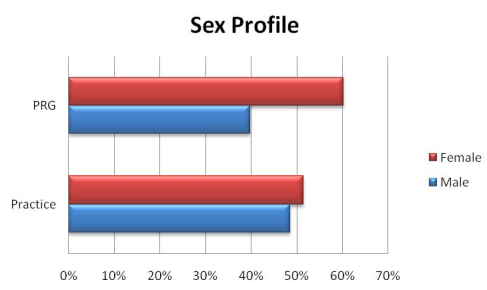
The data we hold on ethnicity is incomplete and cannot be used for comparison purposes. The chart below shows that most of our PRG members are white British (94.28%), which we believe to be a fair representation of our practice population.
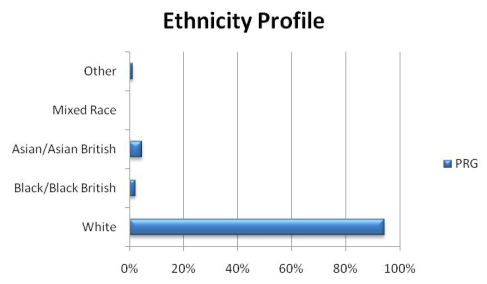
Following on from last year, where we identified housebound patients as a hard to reach group and recruited 9 patients (5 of which are still members), this year we targeted carers. These patients are often very busy in their caring capacity and may not have the time to come into the surgery very often, so they are a group with which it is particularly difficult to engage. A search was performed to identify these patients. We then wrote to 100 carers and invited them to join our PRG. From this exercise we recruited 15 new members, which is a great result.
3. Practice Survey
We contacted all our PRG members, either via email or by letter, with a list of proposed survey options, asking them to choose 5 subjects from a possible 11 on which to survey our patients (see link below).
View the possible survey options (PDF, 15KB)
The 5 most popular choices were: waiting times, clinical care, waiting room facilities, telephone answering and access and on-line prescription ordering. These are the five main areas covered by our local patient survey. The National Patient Survey is a well recognised survey tool so we used it as guidance to create our survey, which was then sent out to the PRG members, asking for input on any amendments/additions.
View the questionnaire (PDF, 128KB)
Once we had received feedback from our PRG members we made the questionnaire available both at the Practice and on this website. The questionnaires were handed out to patients during open surgery. A total of 250 questionnaires were handed out during clinic sessions of which we received a total of 176 completed questionnaires.
On receipt of the completed questionnaires we analysed the data and produced a report with the results, which included an easy to follow pie chart formula. This was sent out to our PRG members, giving them the opportunity for comment and to give their opinions on how we should move forward with this information.
The embedded document below contains full details of all questions included in our survey and is the document that was forwarded to our PRG members:
View the questionnaire results (PDF, 236KB)
All the feedback we received was positive and there were no disagreements. We also encouraged patients to provide us with feedback by completing a form and placing it in our suggestion box, which is checked by Gill Eggleston (Assistant Practice Manager) on a weekly basis. This has so far not proven to be very successful and it is rarely used by our patients. However we will continue to advertise it and patients will be encouraged to use it. We also provide our patients with an opportunity to provide us with feedback on our website and recently we have had some wonderful feedback.
We then wrote the following action plan, which also informed our PRG members on how our actions from last year had been implemented:
View the action plan (PDF, 38KB)
Finally, we sent it to all our PRG members asking them to comment and make suggestions on the following proposed actions. Once again, all feedback was positive with no disagreements. As there have been no changes which impact on contractual arrangements, there has been no need to inform the PCT.
Waiting times
- We are aware that during open surgery some patients may, on occasion, have to wait longer than expected to see a doctor. We feel this has to be balanced against the benefit of being able to have open access to a doctor on the same day.
Clinical care
- To feed back to clinicians the positive results
Waiting room facilities
- We are planning to redecorate our waiting room and put up new notice boards, which will display targeted information in a clear and concise way.
Telephone answering and access
- In order to increase availability of routine appointments, we will raise awareness of open surgery and our ‘Drs’ Messages’ system (this is whereby patients can ring up for advice from a doctor over the telephone). We will ensure patients are aware of these services via the usual methods (ie website, posters etc).
- We will ensure that receptionists answer the results line phone quickly and if the results are unavailable, staff will chase them up, where appropriate.
Online prescription ordering
- To try to ensure maximum uptake of the on line ordering, we are proposing to add a note on all our prescriptions informing patients to contact the surgery if they wish to access this service. We will also ensure that there are further posters in the reception area advertising this. This information is also available on this website.
- We are proposing to offer further training for our staff to enable them to assist patients when they have a problem accessing the on line ordering facility.
Feedback
The feedback we received was very positive and some PRG members congratulated us on the positive survey results. There was no disagreement and there are no contractual considerations to the agreed actions.
One member did ask if we had any plans to introduce on-line appointment booking at the Practice. It was explained that we were looking into this possibility, as there is a problem with patients being able to inadvertently book into Ellesmere Medical Centre appointments as the system stands at the moment.
The report is now available on our website www.dialhousemedicalcentre.nhs.uk; there are also 2 hard copies available for our patients to read in our waiting room.
Practice opening hours
| Monday |
8.30 am to 6.00 pm |
| Tuesday |
8.30 am to 6.00 pm |
| Wednesday |
7.00 am to 1.30 pm |
| Thursday |
8.30 am to 6.00 pm |
| Friday |
8.30 am to 6.00 pm |
| One Saturday per month |
8.00 am to 11.00 am |
Appointments may be booked in person or by telephone.
The surgery is open on Wednesdays from 7am to 8am for patients who work. Both Dr Lund and Dr Gill are available at that time as well as a Practice Nurse and a Health Care Assistant.
Dr Whittaker is available between 8am and 11am one Saturday every month.
Ellesmere Medical Centre
1. Ongoing promotion of our PRG
To build on last year’s creation of our PRG, we have continued to recruit members. This has been achieved by attaching membership forms to new patient registration forms and placing these forms on our front reception desk for existing patients. As a result of this ongoing promotion, we have recruited 9 new members, bringing our total to 65. From this figure we have 2 who expressed a preference for a face to face meeting, 56 that preferred a virtual group and 7 who stated no preference.
As new members joined the PRG, we added their details to our PRG database. We monitored how representative our group was on a monthly basis and accordingly with our findings, we targeted the groups that had low or no representation via reception, opportunistically asking these groups if they would be interested in joining the PRG.
The graphs below show the age, sex and ethnicity profile of our PRG compared to our Practice population.
Age Profile
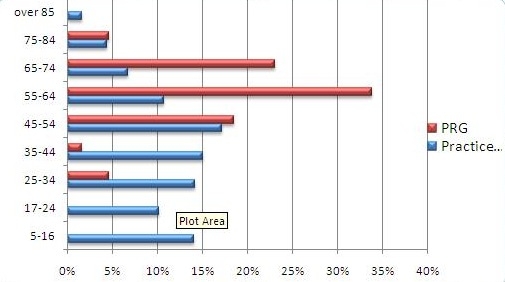
The above chart shows that the PRG distribution is fairly consistent with our Practice population in some age ranges. Nonetheless, the percentage of PRG members in other age ranges is slightly below our expectations. We will continue to focus on these categories with a view to increase their representation.
The male/female ratio of our Practice population is even. However, the male representation in our PRG is significantly below the female representation. We identified this as an issue shortly after we started recruiting members and even though we proactively targeted male patients, the female representation is still predominant. We will continue to encourage male patients to join our Group.
PRG Breakdown
| Age & Sex breakdown |
Male |
Female |
| Under 16 |
0 |
0 |
| 17 to 24 |
0 |
0 |
| 25 to 34 |
0 |
3 |
| 35 to 44 |
4 |
6 |
| 45 to 54 |
9 |
3 |
| 55 to 64 |
13 |
9 |
| 65 to 74 |
6 |
9 |
| 75 to 84 |
3 |
0 |
| Over 84 |
0 |
0 |
Comparative Sex Profile
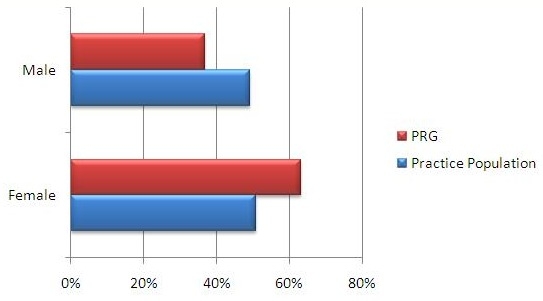
The data we hold on ethnicity is incomplete and cannot be used for comparison purposes. The chart below shows that most of our PRG members are white British (91%), which we believe to be a fair representation of our practice population.
Ethnicity Profile
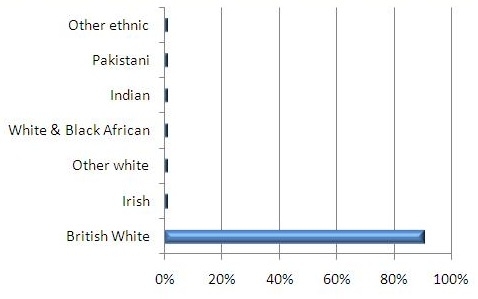
Following on from last year, where we identified housebound patients as a hard to reach group and recruited 2 patients (both of which are still members), this year we targeted carers. These patients are often very busy in their caring capacity and may not have the time to come into the surgery very often, so they are a group with which it is particularly difficult to engage. A search was performed to identify these patients. We then wrote to 100 carers and invited them to join our PRG. From this exercise we recruited 5 new members, which is slightly below our expectations but we feel that at least this group is now represented.
3. Practice Survey
We contacted all our PRG members, either via email or by letter, with a list of proposed survey options, asking them to choose 5 subjects from a possible 11 on which to survey our patients (see below).
View the possible survey options (PDF, 15KB)
The 5 most popular choices were: waiting times, clinical care, waiting room facilities, telephone answering and access and on-line prescription ordering. These are the five main areas covered by our local patient survey. The National Patient Survey is a well recognised survey tool so we used it as guidance to create our survey, which was then sent out to the PRG members, asking for input on any amendments/additions.
View the questionnaire (PDF, 19KB)
Once we had received feedback from our PRG members we made the questionnaire available both at the Practice and on our website. The questionnaires were handed out to patients during surgery. A total of 250 questionnaires were handed out during clinic sessions of which we received a total of 175 completed questionnaires.
On receipt of the completed questionnaires we analysed the data and produced a report with the results, which included an easy to follow pie chart formula. This was sent out to our PRG members, giving them the opportunity for comment and to give their opinions on how we should move forward with this information.
The embedded document below contains full details of all questions included in our survey and is the document that was forwarded to our PRG members:
View the questionnaire results (PDF, 208KB)
All the feedback we received was positive and there were no disagreements. We also encouraged patients to provide us with feedback by completing a form and placing it in our suggestion box, which is checked by Tracy Johnstone (Assistant Practice Manager) on a weekly basis. This has so far not proven to be very successful and it is rarely used by our patients. However we will continue to advertise it and patients will be encouraged to use it.
We then wrote the following action plan, which also informed members on how our actions from last year had been implemented:
View the action plan (PDF, 105KB)
Finally, we sent it to all our PRG members asking them to comment and make suggestions on the following proposed actions. Once again, all feedback was positive with no disagreements. Therefore, because there have been no changes which impact on contractual arrangements there has been no need to inform the PCT.
Waiting times
- These results will be passed on to our clinicians. All our doctors strive to run their clinics on time but not at a cost of patient care as can been seen from our clinical care results.
Clinical care
- We are very pleased with these results and are committed to continuing to provide this quality of care for our patients.
Waiting room facilities
- These results are very positive and will be passed on to our receptionists and team of cleaners.
Telephone answering and access
- We are keen to see an increase in the uptake of our online appointment booking system and make it more accessible for all patients. Therefore, we are going to ensure that this is promoted in the waiting room. We are also going to place it in a prominent position on our website and Practice booklet.
- We are aware at busy times that patients sometimes may have to wait a while for the telephone to be answered. Therefore, in anticipation of this response, we have installed a new arrival screen. As a result of this, our receptionists are more available to answer a higher number of phone calls.
- We found the results for speaking to a Doctor surprising and we wondered if patients were aware that we offer a telephone consultation service which is triaged daily by the on-call doctor. In order to raise patient awareness on this service, we are proposing to publicise this on our website and in our waiting room.
- Test results are only obtainable after 2pm. We will also publicise this in the waiting room and on our website to prevent patients phoning at the wrong time and being unable to receive their results.
On line prescription ordering
- To try to ensure maximum uptake of the online ordering, we are proposing to add a note on all our prescriptions informing patients to contact the surgery if they wish to access this service. We will also ensure that there are further posters in the reception area advertising this. This information is also now available on our website. We are assuming that an increase in the uptake of this service will also help to free up receptionists’ time, which can be diverted to answering the phones.
Feedback
The feedback we received was very positive and some PRG members congratulated us on the positive survey results. There was no disagreement and there are no contractual considerations to the agreed actions.
The report is now available on our website www.ellesmeremedicalcentre.co.uk and there are 2 hard copies available for our patients to read in our waiting room.
Practice Opening Hours
| Monday |
8.00 am to 6.00 pm |
| Tuesday |
7.00 am to 6.00 pm |
| Wednesday |
8.00 am to 6.00 pm |
| Thursday |
7.00 am to 6.00 pm |
| Friday |
8.00 am to 6.00 pm |
| One Saturday per month |
9.00 am to 12.00 am |
Appointments may be booked in person, online or by telephone.
The surgery is open on Tuesdays and Thursdays from 7am to 8am for patients who work. Both Dr Webster and Dr McGuigan are available at that time as well as a Practice Nurse and a Health Care Assistant on a Thursday.
Either Dr Webster or Dr McGuigan is available between 9am and 12pm one Saturday every month.